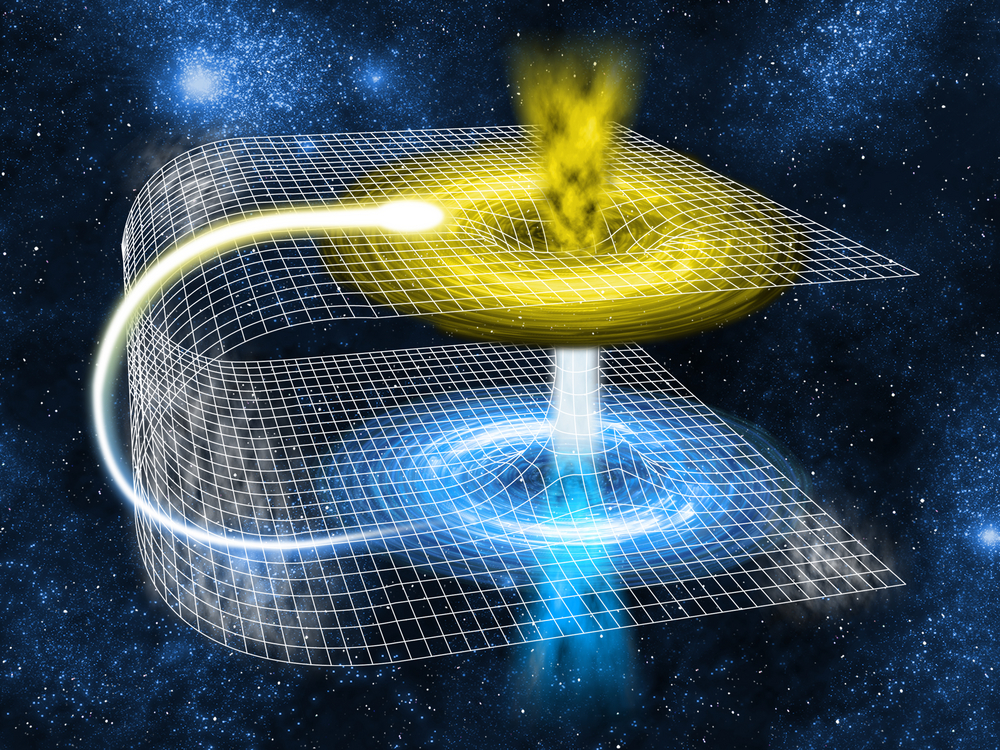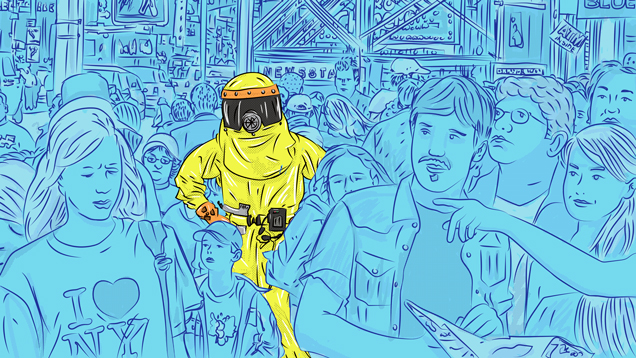Time travel is possible — or at least a lot of serious physicists say so. It’s probably not possible to pull it off in a souped-up Delorean, but there are wormholes, Tipler cylinders, and other Einstein-inspired theories for how it could work. Which raises the question: Why haven’t we met any visitors from another time?
It sounds like a silly question, but it’s one that many scientists actually take very seriously. Meeting someone from the future would, of course, serve as definitive proof that we can indeed travel through time, and that would be a quite a simple way to solve a huge scientific riddle. So it’s no surprise that a handful of enthusiasts and experts have staged experiments in order to attract the time travellers that could be hiding among us.
One of them is Stephen Hawking. The renowned physicist totally believes time travel is a scientific possibility, and even says he knows how to build a time machine. He also famously wondered, “If time travel is possible, where are the tourists from the future?” It’s a good question. Here’s how we’ve tried to answer it.
Why We Think Time Travel Is Possible
Time travel’s been one of man’s wildest fantasies for centuries. But in the last century scientists came up with theories that suggested it was indeed plausible to take a leap into the future. Going back in time, unfortunately, is much more complicated.
According to Einstein’s theory of general relativity, a wormhole could act like a bridge through space-time by connecting two distant points with a shortcut. Certain types of wormholes, it’s theorized, could allow for time travel in either direction, but there are several major caveats of travelling back in time. Mainly, the simple fact that we’d need a method for creating wormholes, and once created, the wormhole would only allow us to travel as far back as the point in time when it was created.
Another option for time travel involves a phenomenon called time dilation, also based on Einstein’s theories of relativity. It refers to the idea that time passes more slowly for a moving clock than it does for a stationary clock. The force of gravity also effects the difference in elapsed time. Thanks to the space program, we’ve actually been dealing with this effect for many years. This is why the clocks on the International Space Station tick just a little bit more slowly than clocks on Earth do.

The implications of this are huge. What if you took this to the extreme? If you jumped in a spaceship that flew super fast, time would pass more quickly for people on Earth. You could do a lap around the galaxy and return to Earth in the future. The question is, how far can we take it? And is it possible to go backwards through time, too?
Once again, we don’t really know. And we won’t really know exactly how that works until we try it, and at the moment, we don’t really have the means to do that. One easy way to find out is simply to search for time travellers walking amongst us. No laboratory required! And that’s exactly what several zany scientists have done.
The Party Approach
One of the earliest well-publicised attempts at finding time travellers was hardly scientific. (I’ll get back to the real scientists in a second, I promise.) It happened in the early 80s, when computers and consumer electronics started merging science and science fiction in fascinating ways. It was also when the first space shuttle, Columbia, blasted off. These sorts of things got people thinking.
A group of artist types in Baltimore acted on these curiosities in 1982 with an event The New York Times described as “an epidemic of temporary lunacy.” In March of that year, all nine planets were as close together as they’d been in almost 200 years, and a group that called themselves Krononauts gathered together to welcome “visitors from the futures.” The Times reports, “The Krononauts drank, danced, and after midnight some of them took off their clothes.” No time travellers actually showed up, but it sounds like everybody had fun.
Fast forward 30 years and a similar — although simultaneously entirely different — party took place in Cambridge, England. This time the ringleader was not a wild pack of twentysomethings but Stephen Hawking himself.
Hawking’s party was wonderfully deliberate. There was champagne and snacks in a fancy room at Cambridge University, where a banner had been hung: “Welcome Time Travellers.” Hawking had always suggested that time travelling tourists could be proof that time travel was possible, so he invited only them. Nobody showed up.
It’s hard to tell how tongue-in-cheek Hawking’s futurefest was supposed to be. On one hand, Hawking believes time travel is feasible, so he wasn’t necessarily laughing at the idea. He might’ve even expected someone to come. But, in Hawking’s words, “There’s a twist.” The sneaky scientist didn’t tell anybody about the party until after it happened. Somebody in the future would have to find out about the event after the fact and hop in a time machine in order to hang out with the famous physicist.
Still, there’s a good chance that Hawking was just trying to prove a point. As his friend and contemporary Kip Thorne explains in his book Black Holes and Time Warps, one of the most feasible methods for building a time machine would involve creating and manipulating wormholes. But this would only allow people in the future to travel back as far as the invention of the time machine itself. So if this is indeed how we might build a time machine and we haven’t built it yet, it would be impossible for people from the future to travel back to Hawking’s party.
The Convention Approach
A few years before Hawking’s party, an ambitious MIT grad student tried a similar but nerdier approach. Instead of keeping the event a secret, Amal Dorai organised a whole convention about time travel and encouraged everybody to spread the world. Dorai wrote on his student website:
We need volunteers to publish the details of the convention in enduring forms, so that the time travellers of future millennia will be aware of the convention. This convention can never be forgotten! We need publicity in MAJOR outlets, not just Internet news. Think New York Times, Washington Post, books, that sort of thing. If you have any strings, please pull them.
Dreams do come true. The New York Times did publish a report. NPR’s All Things Considered did a segment on the convention. Wired wrote a story. Heck, even Tina Fey made fun of it on Saturday Night Live.
The exposure makes pretty good sense. MIT is a famous university that tends to attract media attention anyway. The program was also filled with famous professors talking about time travel. And the premise itself, well, it makes for a pretty fun headline!
It still didn’t work. “The convention was a mixed success,” Dodai said in an update to the event website. “Unfortunately, we had no confirmed time travellers visit us, yet many time travellers could have attended incognito to avoid endless questions about the future.” A similar sort of event happened around the same time in Perth, Australia, to the same disappointing end.
Now, one could argue that Dodai simply underestimated the power of the internet. It would have been hard to tell in 2005, when the convention went down, but the internet won the war against print. Dodai discouraged everyone from publicizing on the internet, because, in his words, “The World Wide Web is unlikely to remain in its present form permanently.” It’s still ticking in 2014.
There’s probably a simpler explanation. It’s the one the MIT physicists came up with, and the same one Hawking suggested: If we eventually discover a particular way to build a time machine that works, people would only be able to travel as far back as when the time machine was built.
The Academic Approach
You can probably already tell how this one’s going to end. Earlier this year, a pair of physicists published the results of a pretty self-explanatory study, “Searching the Internet for evidence of time travellers.” Instead of staging some sort of event and counting on publicity to attract the people of the future, these scientists went on the hunt for evidence of where time travellers had been online. In a sense, they were searching for their digital footprints.
Robert Nemiroff and Teresa Wilson from Michigan Technological University cast their net wide. They searched Twitter. They searched Facebook. They searched Google, Google+, and even Bing. But they came up short. Between January 2006 and September 2013, they couldn’t find a single mention of two terms from the future that people would not have known during that time. None.
It was a good effort. However, given the constraints of the experiment, they ended up searching for a very specific sort of time traveller. Why would that individual be doing putting words from the future on the internet? “A time traveller might have been trying to collect historical information that did not survive into the future, or might have searched for a prescient term because they erroneously thought that a given event had already occurred, or searched to see whether a given event was yet to occur,” the paper explains.
That’s a little bit silly, then, isn’t it. It’s no less silly than throwing a party without inviting anyone or hosting a convention celebrating technology that did not yet exist. No wonder these kinds of events ended up being fodder for sketch comedy shows.
The Fact Of The Matter
All that said, there does seem to be a pretty concrete takeaway that’s rooted in some widely accepted ideas from theoretical physics. We have not yet invented a time machine. If and when we do, we’ll enter a new era of time travel. We will not, however be able to go any further back in time than when that machine was built.
That’s all assuming that this hypothetical time machine can actually go back in time. Again, that’s really difficult.
Time travel is real, though. In a way, the astronauts on board the International Space Station time travel every day, albeit by a few microseconds. The principles of relativity and the very nature of space-time make it possible. So if you really want to meet a time traveller, look no further than your friendly neighbourhood astronaut.

Top image by Sam Woolley / Photos via Flickr / NASA
